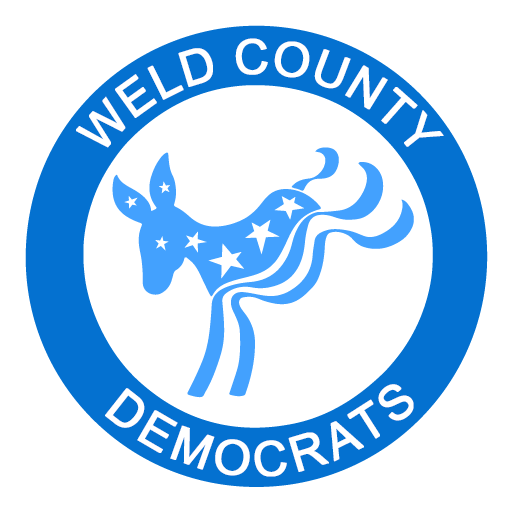2026 Weld County Caucus Information
We will update this section when we have the specific information for Caucus’s and Assemblies.
What you need to know about Weld County Caucus:
Weld County Caucus is Saturday, March 9th, 2024, 9:30-10 am Registration-Check-in and 10:00 am Meeting Convenes
- You must be elected at Caucus to become a Delegate to the County, Multi- County, and State Assemblies. No proxies will be allowed to County Assembly.
- Candidate Preference Polls will be conducted for highest contested statewide race, if any, and for contested Congressional and Legislative District races.
- Designate candidates for Weld County offices.
- Elect delegates to Colorado Democratic Assembly and to Congressional District Assemblies and Multi-County House District Assemblies and Multi-County Senate District Assembies.
Delegates who are elected to County Assembly will receive a OFFICIAL CALL with information on how to pre-register and participate in the assembly.
What is Caucus?
Before the general election, each state has its primaries and caucuses that kick off election seasons. If you’re nodding your head like “yes, of course, the caucus,” but secretly have no idea what the heck everyone is talking about, this explainer is for you.
Before a presidential candidate can be on the ballot for the general election, they have to win the approval and backing of their political party. Think of the caucuses and primaries as the NFL playoffs—with candidates dropping out after each round of voting—and the general election this fall is like the Super Bowl where (usually) two candidates go head to head for access to the oval office.
How Is a Caucus Different Than a Regular Primary?
Every state has either a caucus or a regular primary, but both are part of the primary election process. A regular primary is essentially a ballot election, open to all eligible voters in that party. A caucus is more of a political event, especially for Democrats (more on that in a bit).
Both are run at the state level, but primaries are run by state governments, while caucuses are run by state party officials. In terms of accessibility, voters participate in primaries by casting a ballot at any point during on a primary election day. Caucuses, on the other hand, take place at a very specific time, in a specific place. If you’re late or unavailable, you cannot participate. Caucuses are also a much larger time commitment, with some taking several hours to complete.
What Happens at a Caucus?
So what actually happens at these caucuses? A lot depends on your party affiliation, but there are a few things you can expect no matter who you are. For both Republicans and Democrats, a caucus can be a long affair. Voters will meet at schools, churches, and other community centers across a state’s precincts, and then kick things off. Each precinct chooses or introduces its delegates, or their party representatives to the national convention later this year. Party officials do some last-minute campaigning or give a few speeches, and sometimes presidential candidates will even attend. Finally, after all of that, the actual voting will begin.
That’s where things start to differ dramatically. Here’s the breakdown:
If You’re a Republican:
After hearing some speeches and maybe talking with a few politicos, you cast a secret ballot in a private voting booth just as you would during a regular primary or general election. That’s it for a Republican Party caucus.
If You’re a Democrat:
The voting process at a Democratic Party caucus is a little more physical and time-consuming, but also a little more exciting. Here’s how it all breaks down:
- The total number of voters at the caucus are counted.
- Voters gather in a large room to talk amongst themselves and convince one another their candidate is bigger, stronger, and way cooler.
- Voters are then asked to vote by swarming into groups for each candidate. They may also stand aside in an “undecided” group at first.
- The number of people in each group is then counted off.
- Any candidate that doesn’t have at least 15% of the total headcount is removed.
- Then the “realignment” phase begins. Voters who were in a removed candidate’s group, or part of the undecided pool, must then choose a new candidate to side with. While they decide, voters are allowed to talk to each other (read: shout over) and try to convince the newly unaligned why their candidate is bigger, stronger, and way cooler.
- Once those voters huddle up with their new groups, everyone is counted off again, and candidates with less than 15% of the total headcount are removed.
That process continues until there are only viable candidates left. If this process sounds like it could get intense and loud, you’re correct. This video from inside a 2008 Iowa caucus will give you a little taste.
What Happens After That?
Depending on the state, delegates are divided based on the caucus results and sent to the national party convention to vote for their candidate on behalf of their state. Some states have “binding” primary elections, which are more of a winner-take-all contest. In states with binding primary elections, all of a state’s delegates are awarded to one candidate. Other states have “proportional” primary elections, where delegates are awarded in proportion to the popular vote. Finally, there are “non-binding” primary elections. Non-binding primary elections first select candidates for a state convention, where those candidates vote for how to divide the state’s delegates.
Some states start even smaller and select candidates for a county convention, who then select candidates for a state convention, who then finally vote for delegates to the national convention. It all varies by state.
Finally, the delegates from each state go to their respective party’s national convention and cast their vote for their party’s presidential nominee. They usually vote based on the results in their precinct, so it’s not uncommon for winners to be forecast early on. That said, delegates aren’t necessarily required to uphold their pledge, so a close race can still be anybody’s game. After the delegate’s votes are counted, each party announces their presidential nominee.
How You Can Get Involved
If you want to be part of the process, caucuses are a chance for you to put your vote where your mouth is. There are a few things you should know, first:
- Find out if your state’s caucus is closed or open. Some are “closed,” which means you can only participate if you are a registered member of that political party. Nevada, Wyoming, Colorado, Nebraska, Kansas, Maine, Alaska, and Hawaii all have closed caucuses. Some are “open,” meaning a registered voter may participate in any caucus regardless of party affiliation. Washington, Idaho, North Dakota, and Minnesota all have open caucuses. You can refer to the Election Central list from earlier to see what type of caucus is held in your state.
- The earlier you can register to vote the better. A caucus is different than a standard primary, but you still need to be a registered voter. Almost every caucus state allows same-day voter registration, but some (like Colorado) require you to be registered beforehand. Even if your state does offer same-day voter registration, you’ll probably save everyone some time by registering beforehand.
- Be punctual. To participate in a caucus, you absolutely must be on time. Both parties are very strict with that.
The voters you’ll find at caucuses are usually a little more politically involved, but that doesn’t mean you can’t or shouldn’t participate. So get registered and to be the change that you seek.
Explainer provided by lifehacker.com What are Caucuses and How Do They Work?
There Are Many Other Ways To Get Involved
It's easy to think one person can't make a difference. That's simply not true. You can make a difference. Start today!


